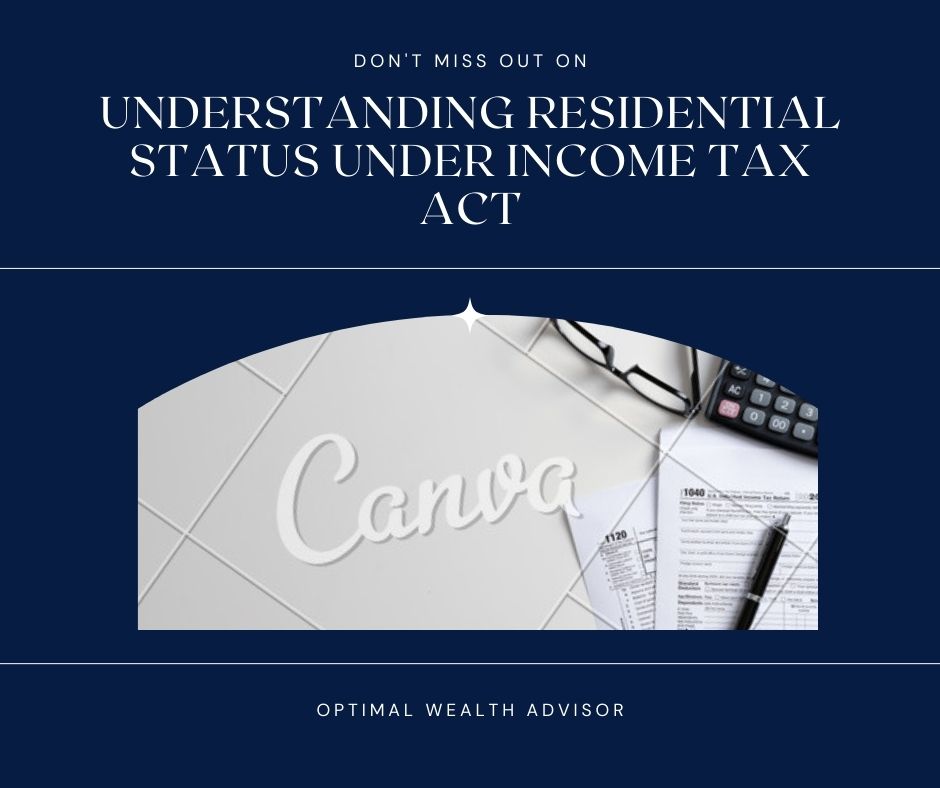The concept of residential status plays a crucial role in determining tax liability in India. As a CA aspirant, understanding the nuances of residential status is essential for acing your exams and becoming a tax expert. This blog post will serve as a comprehensive guide, delving into the different categories, relevant provisions, and practical examples.

Table of Contents
Understanding the Basics of Residential Status
The Income Tax Act, 1961 (hereafter referred to as the Act) classifies individuals into three categories based on their residential status in a particular financial year (FY) [Section 6(1) of the Act]:
- Resident and Ordinarily Resident (ROR): These individuals are deemed to be residents of India throughout the FY. They are either:
- Physically present in India for 182 days or more during the FY.
- Physically present in India for 60 days or more during the FY and have been in India for 365 days or more in the four preceding FYs.
- Resident but Not Ordinarily Resident (RNOR): These individuals are considered residents only for the specific FY. They fulfill either of the following conditions:
- Physically present in India for 182 days or more during the FY.
- Physically present in India for less than 182 days but were residents of India for at least two out of the ten preceding FYs.
- Non-Resident (NR): These individuals are not considered residents of India for the FY. They either:
- Were not physically present in India for any part of the FY.
- Were present for less than 60 days in the FY.
Tax Implications of Residential Status:
The residential status significantly impacts how an individual is taxed in India:
- RORs: Taxed on their worldwide income in India.
- RNORs: Taxed on their income accruing or arising in India and any income received in India.
- NRs: Taxed only on their income accruing or arising in India and specific income received in India, like long-term capital gains exceeding Rs. 250,000.
Detailed Example of Residential Status
Scenario: Mr. Sharma, a resident of India, worked in Dubai for the entire FY 2023-24. He was present in India for only 45 days during the FY. He earned a salary of Rs. 50 Lakhs from his Dubai-based employer and Rs. 2 Lakhs interest income from an Indian bank account.
Analysis:
- Physical Presence: Mr. Sharma was not present for 182 days or 60 days in India.
- Previous Year Presence: Information about his presence in the preceding FYs is not provided.
Based on the available information, Mr. Sharma would be classified as a Non-Resident (NR) for FY 2023-24. Consequently, he will only be taxed on:
- Income accruing or arising in India: This includes the Rs. 2 Lakhs interest income from the Indian bank account.
- Specific income received in India: Since the long-term capital gains exemption limit is Rs. 250,000, he will not be taxed on the interest income.
Key Takeaways:
- Determining residential status is crucial for calculating tax liability in India.
- The Act categorizes individuals as ROR, RNOR, or NR based on their physical presence and previous year presence.
- Each category has distinct tax implications, with RORs being taxed on their worldwide income, RNORs on their Indian income and specific income received in India, and NRs only on their Indian income and specific income received in India.
Frequently Asked Questions (FAQs):
Q: What if an individual is present in India for exactly 182 days?
A: If an individual is present in India for exactly 182 days, they will be considered an ROR if they have any other ties to India, such as owning a house or having a business here. However, if they have no other ties, they might be able to argue their case for being an RNOR.
Q: How does the residential status of a company affect its taxes?
A: Companies are classified as resident or non-resident based on their place of incorporation. Resident companies are taxed on their worldwide income, while non-resident companies are only taxed on their income accruing or arising in India.
Residential Status: Beyond the Basics
Having grasped the fundamental categories and tax implications, let’s delve deeper into specific provisions and nuances relevant to CA aspirants:
Deemed Residents [Section 6(6) of the Act]:
The Act deems certain individuals as residents even if they don’t meet the usual criteria for ROR or RNOR. These individuals include:
- Individuals with a total income exceeding Rs. 15 Lakhs in a FY, where at least Rs. 5 Lakhs are earned from India.
- Members of Parliament (MPs) and Members of Legislative Assemblies (MLAs) for the relevant FY.
- Government servants deputed outside India for more than 182 days.
Special Provisions for Students [Section 6(7) of the Act]:
Students pursuing full-time education abroad are generally considered non-residents, even if they are Indian citizens. However, if their total income exceeds the basic exemption limit (currently Rs. 5 Lakhs) and includes income from India exceeding Rs. 2.5 Lakhs, they might be considered residents.
Case Studies and Practical Application:
Understanding residential status through real-world scenarios can solidify your grasp of the concept. Here’s an example:
Scenario: Ms. Malhotra, an Indian citizen, worked in the United States for the entire FY 2023-24. She was present in India for only 30 days during the FY. Her total income for the FY was Rs. 60 Lakhs, out of which Rs. 10 Lakhs was earned from rental income on her property in India.
Analysis:
- Physical Presence: Ms. Malhotra doesn’t meet the criteria for ROR or RNOR based on physical presence.
- Total Income: Her total income exceeds Rs. 15 Lakhs, and more than Rs. 5 Lakhs are earned from India.
Since Ms. Malhotra falls under the “deemed resident” category due to her income exceeding the specified limit, she will be taxed on her worldwide income in India for FY 2023-24.
Tips for CA Aspirants:
- Master the relevant sections of the Act (Section 6 and its sub-sections) to understand the various categories and exceptions.
- Practice solving case studies and mock exams to apply your knowledge and develop critical thinking skills.
- Stay updated on any changes or amendments made to the Act through official sources like the Income Tax Department website.
Conclusion:
Understanding residential status is not just a theoretical concept but a vital aspect of tax assessment. By thoroughly comprehending the different categories, relevant provisions, and practical applications, you can excel in your CA exams and confidently navigate the complexities of tax calculations. Remember, a strong foundation in this area will prove invaluable throughout your career as a Chartered Accountant.
Do checkout our previous article on gst applicability by clicking here.

